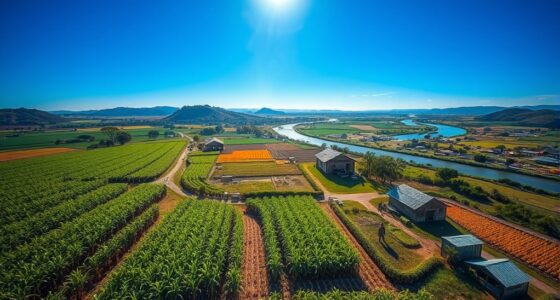Flooding rice fields creates a unique environment that limits weed growth and reduces pest populations. This submerged condition helps rice plants thrive while stifling weeds, decreasing their density by up to 90%. You'll see lower pest activity, with some studies showing a 50% less need for pesticides. Additionally, the waterlogged soil improves crop health and boosts yields by 10-20%. By fostering natural pest control methods, like introducing fish, flooding promotes sustainability in farming practices. If you want to explore more about the benefits and techniques of this method, there's plenty more to discover!
Key Takeaways
- Flooding creates conditions that suppress weed seed emergence, reducing weed density by up to 90% and minimizing herbicide reliance.
- Waterlogged environments disrupt pest life cycles, leading to significantly lower pest populations and decreased pesticide needs, as shown in various studies.
- Controlled water levels optimize conditions for rice while inhibiting weed competition, fostering natural pest management and reducing chemical inputs.
- Incorporating fish in flooded rice fields promotes biological control of harmful larvae, further enhancing natural pest management strategies.
- Economic savings from reduced herbicide and pesticide use, combined with healthier crop yields, promote sustainable agricultural practices for farmers.
Mechanism of Flooding
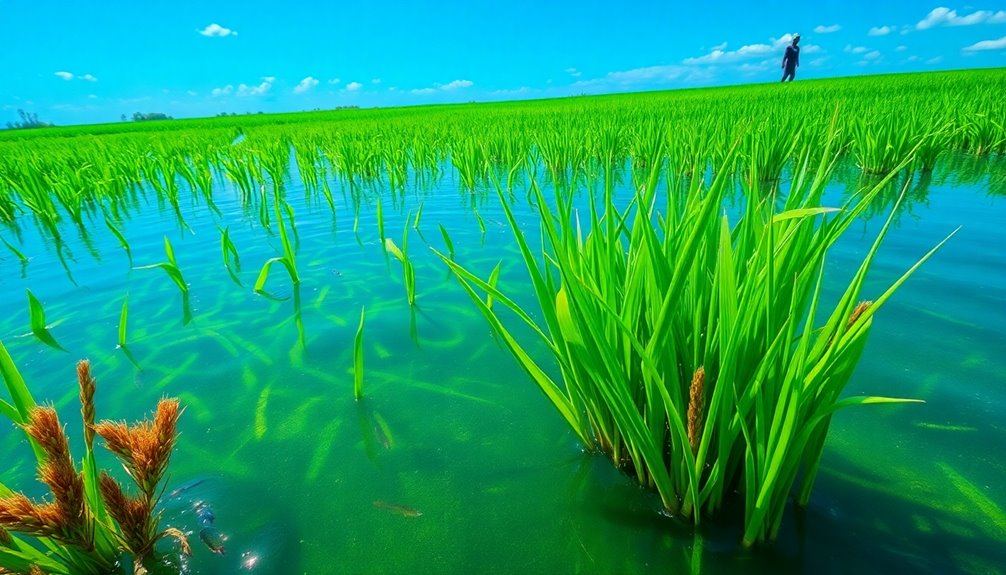
Flooding rice fields is an effective strategy that creates an ideal environment for rice growth while curbing weed and pest development.
When you flood the fields, the submerged conditions favor rice plants but hinder most weeds, which aren't adapted to thrive underwater. This natural flooding greatly limits pest populations, as many pests struggle to survive in such conditions.
Additionally, incorporating fish into flooded fields serves as a biological control method, as they consume harmful larvae and other pests. The water acts as a barrier, reducing the need for synthetic pesticides and minimizing reliance on herbicides.
Research shows that flooded fields consistently exhibit lower weed density and pest populations, making flooding a practical and environmentally friendly approach to rice cultivation.
Benefits for Rice Growth
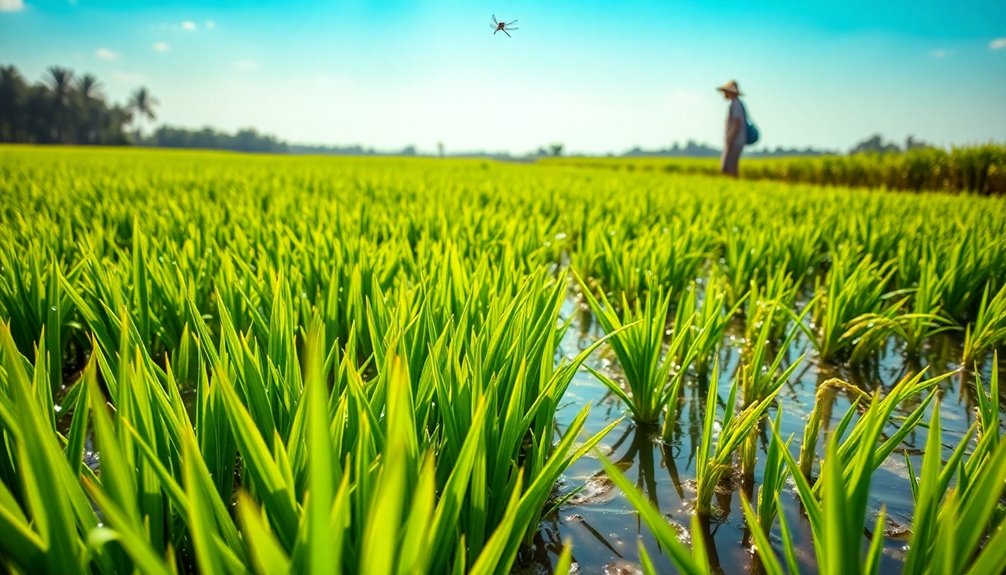
The submerged conditions of flooded rice fields greatly boost rice growth while suppressing unwanted weeds. In these flooding fields, the water creates an environment where most weed species struggle to thrive, reducing weed growth considerably. Additionally, the presence of water deters common pests, leading to a healthier crop.
| Benefit | Description |
|---|---|
| Enhanced Growth | Flooded fields promote strong rice plant development. |
| Weed Suppression | Weeds are less competitive in submerged conditions. |
| Pest Control | Water deters pests and supports natural predators. |
| Nutrient Enrichment | Aquatic plants like azolla enrich soil with nitrogen. |
Weed Suppression Techniques
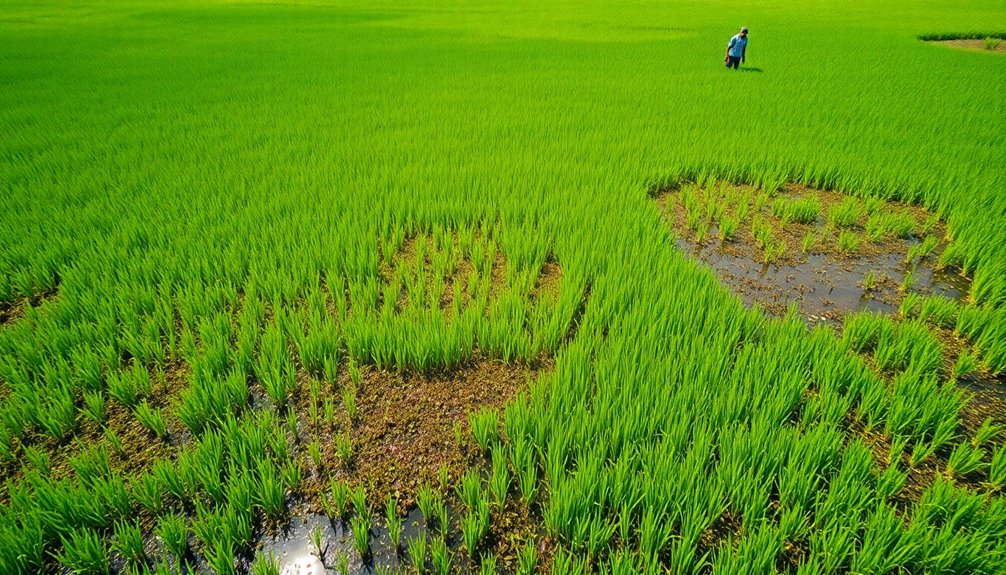
Creating an effective weed suppression strategy is essential for maintaining healthy rice crops. Flooding rice fields creates anaerobic conditions that suppress weed growth, allowing your crops to thrive.
Here are some key techniques you can implement:
- Flooding: Submerging fields limits weed seed emergence and reduces weed density by up to 90%.
- Water Level Control: Manage water levels to optimize conditions for rice while inhibiting weed competition.
- Natural Competition: Encourage aquatic vegetation that competes with weeds, enhancing your crop's resilience.
- Minimize Herbicide Use: With effective weed suppression, you can greatly reduce herbicide applications, fostering a healthier ecosystem.
Natural Pest Management

Natural pest management thrives in flooded rice fields, where submerged conditions create an environment that most pests find inhospitable. Research shows that pest populations in these fields are considerably lower than in non-flooded areas, which means you can rely less on chemical pesticides.
Additionally, the presence of fish plays an essential role in natural pest control, as they actively consume larvae and other pests, enhancing your pest management efforts. Waterlogged conditions not only suppress common rice pests but also disrupt their life cycles, resulting in healthier, more stable crop yields.
Environmental Advantages
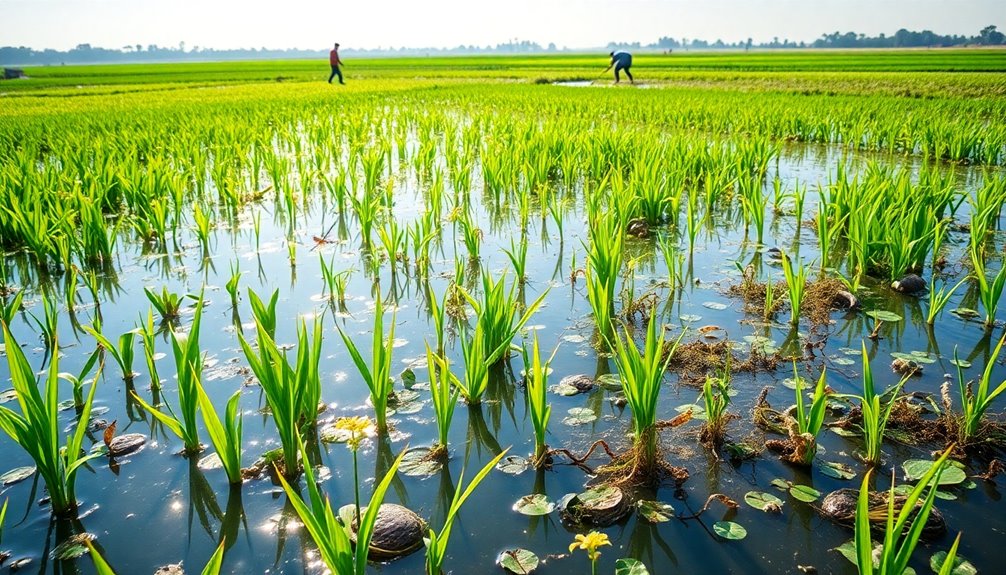
Flooded rice fields offer significant environmental advantages that go beyond improved pest management. By implementing this practice, you contribute to a healthier ecosystem.
Here are four key benefits:
- Reduced Herbicide Use: The submerged conditions suppress weed growth, minimizing the need for chemical herbicides.
- Lower Pesticide Reliance: Many rice pests struggle to survive underwater, leading to decreased pesticide application.
- Waterway Protection: With less chemical runoff, you help safeguard aquatic ecosystems and maintain biodiversity.
- Enhanced Soil Health: Flooding promotes natural nutrient cycling, resulting in healthier soil that supports robust crop growth and reduces disease susceptibility.
These advantages not only support sustainable farming but also promote the long-term health of our environment.
Economic Savings for Farmers

By adopting flooded rice field practices, farmers can enjoy significant economic savings. Flooding reduces the need for herbicides and pesticides, leading to lower input costs that can save you hundreds to thousands of dollars each year. Studies show you could cut herbicide use by up to 50%, while healthier crops can yield 10-20% more. Plus, sustainable methods may help you sell organic rice at higher prices, tapping into the growing demand for eco-friendly products. Over time, these practices improve soil health and contribute to your economic resilience, decreasing reliance on external inputs.
| Cost Reductions | Yield Increase | Market Advantage |
|---|---|---|
| Lower input costs | 10-20% more | Premium organic prices |
Cultural Significance of Flooding

Embracing the practice of flooding rice fields connects you to centuries of agricultural tradition, particularly in Asia, where rice is more than just a staple food—it's a cultural cornerstone.
This method not only preserves cultural heritage but also fosters a unique ecosystem that enhances biodiversity.
Here are some key cultural significance points:
- Seasonal Festivals: Flooding aligns with local rituals celebrating rice cultivation.
- Community Bonds: It strengthens relationships among farmers through cooperative practices.
- Traditional Knowledge: This approach integrates age-old wisdom with modern sustainable agriculture techniques.
- Environmental Health: The flooded fields promote ecological balance, reflecting the interdependence of culture and nature.
Case Studies and Evidence

Let's take a closer look at the research findings on flooding rice fields.
You'll find successful examples of implementation that showcase its benefits, from reduced herbicide use to increased yields.
Research Findings Overview
Flooding rice fields has shown remarkable benefits in agricultural practices, as numerous studies underscore its effectiveness in managing weeds and pests.
Here are some key research findings:
- Weed Reduction: Up to a 70% decrease in weed competition compared to non-flooded fields.
- Pest Population Declines: Over 50% decline in common rice pests in submerged conditions.
- Reduced Herbicide Use: Farmers practicing flooding have cut herbicide usage by an average of 30%, lowering costs and promoting healthier ecosystems.
- Increased Crop Yields: Yields improve by approximately 15% with healthier crops and enhanced soil quality.
These findings clearly demonstrate that flooding rice fields not only reduces the need for herbicides and pesticides but also fosters sustainable agricultural practices.
Successful Implementation Examples
Numerous successful implementation examples highlight the benefits of flooding rice fields across various regions.
In the Philippines, farmers using flooding techniques slashed herbicide usage by 30% compared to traditional methods.
Similarly, research in Vietnam showed that flooding rice fields reduced pest populations, leading to a 40% drop in pesticide applications over three growing seasons.
In Bangladesh, integrating fish into flooded fields not only controlled pests but also boosted rice yields by 20%, showcasing biodiversity's role in productivity.
Additionally, case studies from India revealed farmers saved an average of $200 per hectare annually on herbicides and pesticides.
Evidence from China confirmed that flooded rice fields increased beneficial insect populations by 25%, further reducing reliance on chemical pest control.
Comparative Yield Analysis
The positive outcomes from successful implementations of flooding techniques naturally lead to an examination of yield performance in rice cultivation.
You'll find compelling evidence showing how flooding impacts herbicide and pesticide use while boosting yields:
- In the Philippines, flooded fields saw a 30% reduction in weed density, cutting herbicide needs considerably.
- Indian farmers experienced a 20% increase in rice yields due to healthier plants and fewer pests.
- Vietnamese studies revealed a 50% reduction in pesticide application, lowering production costs.
- In Thailand, flooded farms had a 40% lower incidence of common pests, enhancing crop resilience.
These case studies underline the effectiveness of flooding methods in improving yields while minimizing reliance on herbicides and pesticides.
Future of Sustainable Practices

As you explore innovative water management strategies, consider how flooding techniques can be scaled globally to enhance sustainability.
These methods not only improve crop resilience but also reduce chemical reliance in farming.
Innovative Water Management Strategies
Embracing innovative water management strategies can transform agricultural practices, particularly in rice cultivation. Flooding rice fields creates an environment that naturally suppresses weeds and pests, reducing your reliance on herbicides and pesticides.
Here are some key benefits:
- Reduced Herbicide Use: Flooded fields can cut herbicide usage by up to 50%, leading to cost savings and environmental benefits.
- Natural Pest Control: Incorporating fish into these systems promotes natural pest control, enhancing ecological balance.
- Improved Soil Health: Sustainable water management enhances soil fertility, supporting healthier crops.
- Biodiversity Boost: These practices promote greater biodiversity, essential for long-term agricultural sustainability. Additionally, similar sustainable harvesting practices are encouraged in foraging communities to maintain ecological balance.
Scaling Practices Globally
Scaling sustainable practices in agriculture is essential for addressing global food security and environmental challenges.
By adopting flooding techniques in rice farming, you're not just enhancing crop resilience but also reducing herbicide use by up to 90%. This significant reduction opens the door for broader ecological benefits across various crops.
Educational initiatives can empower farmers like you worldwide, inspiring a shift toward sustainable agriculture. Countries facing climate change challenges can particularly benefit from these practices, as they enhance water retention and support crop production. Additionally, the integration of renewable energy technologies can further bolster the sustainability of agricultural practices.
Collaboration among governments, research institutions, and farmers can further facilitate the scaling of flooding techniques, influencing agricultural policies to promote sustainable farming methods globally.
Together, we can create a more sustainable future.
Global Perspectives on Flooding
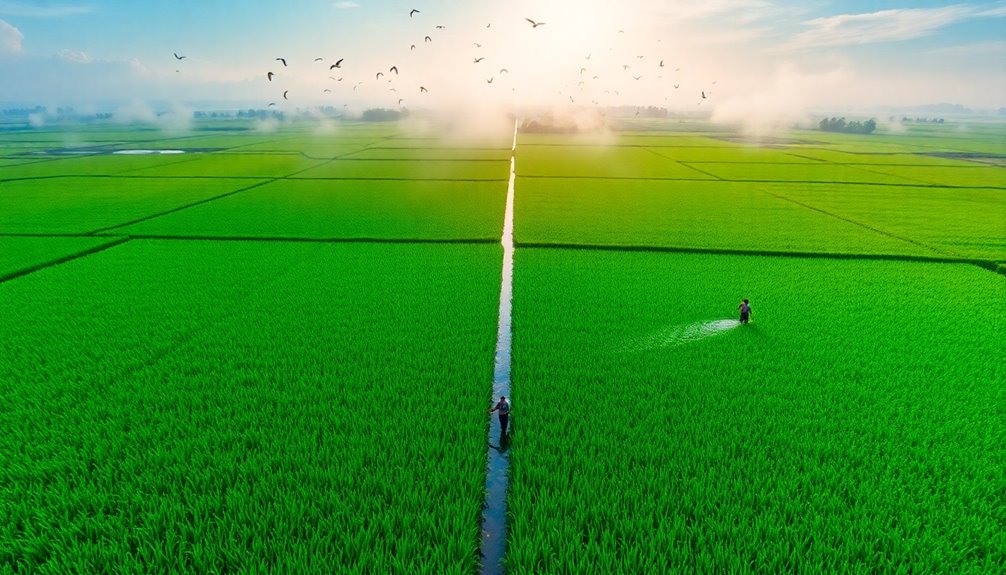
While traditional practices vary across regions, flooding rice fields has gained recognition globally for its multifaceted benefits. This method not only boosts crop productivity but also reduces reliance on harmful chemicals.
Here are some key advantages of flooding rice fields:
- Reduced Herbicide Usage: Studies show up to 50% lower herbicide use due to decreased weed density.
- Lower Pesticide Applications: Pest populations decline, resulting in about 30% less pesticide use.
- Enhanced Biodiversity: Flooding promotes diverse ecosystems, fostering beneficial organisms.
- Carbon Sequestration: Flooded fields can capture more carbon, aiding climate change mitigation.
Additionally, this approach aligns with sustainable farming practices that emphasize environmental health and reduced chemical inputs.
These global initiatives highlight the environmental and agricultural advantages of flooding, making it a viable solution for sustainable rice farming.
Frequently Asked Questions
How Flooding Rice Fields Reduce the Need for Herbicides and Pesticides in Rice Farming?
Flooding rice fields considerably cuts down your need for herbicides and pesticides.
When you submerge the fields, most weeds can't survive, which means less competition for your rice. Additionally, the flooded environment deters pests that might otherwise harm your crops.
By using this method, you're promoting healthier yields while also reducing chemical inputs, ultimately supporting sustainable farming practices that benefit both your wallet and the environment.
It's a win-win for you!
How Does Flooding Rice Fields Reduce the Need for Herbicides and Pesticides in Rice Farming Quizlet?
Flooding rice fields creates an environment that most weeds and pests can't tolerate, so you see a natural decline in their populations.
As you flood the fields, beneficial aquatic plants thrive, enhancing soil fertility and reducing the need for synthetic fertilizers.
This method effectively minimizes chemical usage, promoting healthier ecosystems.
You'll find that flooded fields show lower weed density and pest populations, making your rice farming more sustainable and efficient.
How Does Flooding Rice Fields Reduce the Need for Herbicides and Pesticides in Rice Farming Brainly?
You might've noticed how some farmers seem to have fewer weeds and pests in their flooded rice fields.
This happens because the waterlogged conditions create a tough environment for most unwanted plants and insects. As a result, you won't need as many herbicides or pesticides.
Plus, when you add fish to the mix, they help control pests naturally.
Why Do Rice Fields Need to Be Flooded?
You flood rice fields to create an environment that's ideal for rice growth.
The water suppresses weeds, making it easier for your crops to thrive without competing for resources. It also helps control pests and diseases, reducing your reliance on chemicals.
Flooding promotes beneficial aquatic plants that enrich the soil, enhancing fertility.
Conclusion
In a world where nature dances with agriculture, flooding rice fields paints a vibrant picture of sustainability. By embracing this age-old practice, you not only cultivate healthier crops but also nurture the earth, reducing reliance on harmful chemicals. It's like weaving a tapestry of life, where each thread—be it plant, pest, or water—harmonizes beautifully. As you look to the future, consider this method as a flourishing pathway towards a greener, more resilient agricultural landscape.





